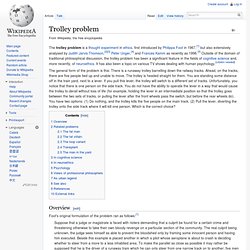

Trolley problem. The trolley problem is a thought experiment in ethics, first introduced by Philippa Foot in 1967, but also extensively analysed by Judith Jarvis Thomson,[2][3] Peter Unger,[4] and Frances Kamm as recently as 1996.[5] Outside of the domain of traditional philosophical discussion, the trolley problem has been a significant feature in the fields of cognitive science and, more recently, of neuroethics.

It has also been a topic on various TV shows dealing with human psychology. [citation needed] The general form of the problem is this: There is a runaway trolley barrelling down the railway tracks. Ahead, on the tracks, there are five people tied up and unable to move. The trolley is headed straight for them. Overview[edit] Foot's original formulation of the problem ran as follows: Suppose that a judge or magistrate is faced with rioters demanding that a culprit be found for a certain crime and threatening otherwise to take their own bloody revenge on a particular section of the community. The Art of Complex Problem Solving. The brain’s silent majority - 2009 FALL. When you have no clue, call it glue.

“Glia,” the Greek word for glue, was the name the pathologist Rudolph Virchow gave, back in 1856, to the gelatinous substance that forms the bulk of the brain. And it stuck. These days, scientists use it to denote the matter that accounts for 90 percent of the brain’s cells and more than half its volume — but, like the late comic Rodney Dangerfield, “can’t get no respect.” Neurons, the “talented tenth” of the human brain that hog the lion’s share of brain scientists’ attention, are indeed a work of evolutionary art. They’ve got a knack that glia lack: Their aptitude for high-speed, long-distance communication makes them the nervous system’s premier information processors. “When the brain is injured, the neighborhood astrocytes go into a completely altered state.”
We now know they’re doing much more. Certainly, it’s no stretch to imagine that knowing what glial cells do, and how they do it, could help explain brain disorders and how to cure them. Beginning Game Development: Part VIII - DirectSound. Welcome to the eighth article on beginning game development.

We have spent a lot of time working with the graphics capabilities of DirectX. We also covered how the DirectX API allows us to control input devices. Now we are going to look at another facet of DirectX, the ability to control sound devices. This capability is found in the DirectSound and AudioVideoPlayback namespaces. Sound in Games Sound creates an ambiance in a game that provides for a more immersive game experience. Sound effects also provide the same audible cues we expect in real life, such as the direction and speed of a person approaching us based on the volume, direction, and frequency of the footsteps.
In BattleTank2005 I want to integrate sound in the following way. Secondly, I want to be able to play background music during game play and I want to control what music plays when in the game. DirectSound The DirectSound namespace only supports playing 2 channel waveform audio data at fixed sampling rates (PCM). Device. Logical Paradoxes.